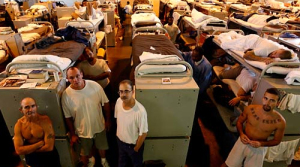New America Media, Commentary, Raj Jayadev
In 1999, about this time of the year, I was hanging billboard-size banners off freeway overpasses with a bunch of people I just met that morning. The spray-painted bedsheets read “No on Prop 21!” and “Stop Criminalizing Youth of Color.”
We were part of California’s burgeoning youth movement – mainly twentysomethings who were coming of age at a fork-in-the-road moment for the state in terms of how it viewed, responded to and served its young people.
Proposition 21 was a “tough-on-crime” initiative from a continuum of policies set in the 1980s. Under its language, juveniles could be charged as adults, which would significantly increase prison sentences for a broad array of felonies. Ultimately, it promised to dramatically increase California’s incarceration rates.
California voters passed Proposition 21 (despite massive organizing by young people). It committed California — financially and ethically — to the notion that “lock-them-up politics” was a sound public safety framework to move us forward. Generations of California’s youth have been paying the price ever since.
Our prisons are now so crowded that the U.S. Supreme Court found them in violation of constitutional protections against cruel and unusual punishment. And the money required to support the exponential growth in California’s incarceration numbers has depleted public resources that could have gone to opportunities and supportive structures for youth through education and social services.
And a more subtle consequence has burrowed itself into the consciousness of many Californians. That is, youth of color in California grow up knowing that the adult generation sees them as threats to be controlled, rather than potential in which to be invested.
The decision to choose incarceration over education has been so calcified into our funding priorities that one can see it just from the institutions we choose to build. In the time it took to build 22 prisons in California, we have built only one University of California campus.
Now, California stands at a moment of potential redemption in this coming election through Proposition 47 – an opportunity to recalibrate our state compass from prisons and jails to schools and communities.
The proposition will reduce certain low-level felonies, such as simple drug possession, check forgery and shoplifting or theft of property equal to $950 or less, to misdemeanors.
The result would stop thousands of people from going to a prison system that has a recidivism rate of over 60 percent – a statistic that shows it perpetuates more criminality than it prevents.
Reducing the charging practice from felony to misdemeanor would also prevent people from carrying an “F” (which stands for felony and is the modern-day scarlet letter) on their record which excludes them from housing, employment and social services for the rest of their lives. These are the very lifelines that could break a cycle of incarceration.
The resources saved through “decarceration” would be invested into K-12 school programs, crime prevention and mental health and drug treatment. We are talking about hundreds of millions of dollars.
Like many of my generation who were politicized through the fight against Proposition 21 in 1999, I still work at an organization that serves the very youth of color that proposition targeted.
During the week, young people who go to underserved, crowded schools come to our community center to learn media skills, work on social justice campaigns and just be in a place that truly believes in them for a couple hours each day.
During the weekend, we host meetings for families whose loved ones face criminal charges and are looking for some support through the most challenging moments of their lives.
I can’t tell you the number of times I felt that if a young person had been to our center during the week – or any other positive program for that matter – I wouldn’t have had to see them at a weekend meeting dealing with the prospect of prison. Proposition 47 could make that switch a reality.
I remember back in the Proposition 21 days, I was charged with a defiant energy against electoral politics and its limitations. An older, more seasoned activist, once said at a rally: “You don’t ever win what you want at the ballot box, but you can lose what you got.”
I’ve remembered that phrase as gospel.
Today’s youth can’t afford to be so skeptical. They actually have a chance to win something this election – their future.
This year’s campaign is different with tactics. There are hashtag campaigns and viral videos rather than banner drops and sit-in take-overs of hotel lobbies, but the fight to define California priorities for youth is the same.
The Proposition 47 campaign has gained the support of elected officials, district attorneys and famous pop stars. I’m glad the message is being more widely received because the stakes are undeniably higher than ever.
Raj Jayadev is executive director of Silicon Valley De-Bug, a community organizing, advocacy and media organization in San Jose, Calif.
